Fe-Ti Oxide Assemblages from the Contact-Metamorphosed Mafic-Ultramafic Rocks of the Sedova Zaimka Intrusion (Western Siberia, Russia): The Tracking of Metamorphic Transformations
Abstract
1. Introduction
2. Regional Setting and Geology of the Sedova Zaimka Intrusion
3. Petrography of the Sedova Zaimka Intrusion
4. Cu–Ni Sulfide Mineralization of the Sedova Zaimka Intrusion
5. Materials and Methods
6. Results
6.1. Petrography of Fe-Ti Oxide Minerals
6.2. Ilmenite–Sulfide and Ilmenite–Titanite–Sulfide Relationships
6.3. Fe-Ti Oxide Mineral Chemistry
6.4. Fe–Ti oxide geothermometry and oxygen geobarometry.
7. Discussion
7.1. Typification of Ilmenites from the Sedova Zaimka Intrusion
7.2. Type I Ilmenite: Implications from Magnetite–Ilmenite Intergrowths
7.3. Types II to V Metamorphosed Igneous Ilmenite: Textural and Compositional Transformations
7.4. Ilmenite–Sulfide and Ilmenite–Titanite–Sulfide Relationships: The Background to the Ti-Magnetite Precursors
7.5. A General Model for Fe-Ti Oxide Evolution in Metamorphosed Mafic–Ultramafic rocks of the Sedova Zaimka Intrusion
8. Conclusions
Supplementary Materials
Author Contributions
Funding
Acknowledgments
Conflicts of Interest
References
- Bateman, A.M. The formation of late magmatic oxide ores. Econ. Geol. 1951, 46, 404–426. [Google Scholar] [CrossRef]
- Braun, E.; Raith, M. Fe-Ti-oxides in metamorphic basites from the Eastern Alps, Austria: A contribution to the formation of solid solutions of natural Fe-Ti-oxide assemblages. Contr. Mineral. Petrol. 1985, 90, 199–213. [Google Scholar] [CrossRef]
- Force, C.E. Geology of titanium mineral deposits. Geol. Soc. Am. Spec. Pap. 1991, 259, 1–112. [Google Scholar] [CrossRef]
- Frost, B.R.; Lindsley, D.H. Occurrence of iron–titanium oxides in igneous rocks, Oxide Minerals: Petrologic and Magnetic Significance. Mineral. Soc. Am. Rev. Mineral. 1991, 25, 433–468. [Google Scholar]
- Cawthorn, R.G. Layered Intrusions; Elsevier: Amsterdam, The Netherlands, 1996; p. 531. [Google Scholar]
- Robinson, D.; Bevins, R.E. Patterns of Regional Low-Grade Metamorphism in Metabasites; Frey, M., Robinson, D., Eds.; Low-Grade Metamorphism, Blackwell Science Ltd.: Oxford, UK, 1999; pp. 143–168. [Google Scholar]
- Pang, K.N.; Zhou, M.-F.; Lindsley, D.; Zhao, D.G.; Malpas, J. Origin of Fe-Ti oxides ores in mafic intrusions: Evidence from the Panzhihua intrusion, SW China. J. Petrol. 2008, 49, 295–313. [Google Scholar] [CrossRef]
- Pang, K.-N.; Zhou, M.-F.; Qi, L.; Shellnutt, G.; Wang, C.Y.; Zhao, D. Flood basalt-related Fe-Ti oxide deposits in the Emeishan large igneous province, SW China. Lithos 2010, 119, 123–136. [Google Scholar] [CrossRef]
- Hansen, E.; Reimink, J.; Harlov, D. Titaniferous accessory minerals in very low-grade metamorphic rocks, Keweenaw Peninsula Michigan, USA. Lithos 2010, 116, 167–174. [Google Scholar] [CrossRef]
- Charlier, B.; Namur, O.; Bolle, O.; Latypov, R.; Duchesne, J.-C. Fe-Ti-V-P ore deposits associated with Proterozoic massif-type anorthosites and related rocks. Earth Sci. Rev. 2015, 141, 56–81. [Google Scholar] [CrossRef]
- Su, X.; Peng, P.; Wang, C.; Sun, F.; Zhang, Z.; Zhou, X. Petrogenesis of a ~900 Ma mafic sill from Xuzhou, North China: Implications for the genesis of Fe-Ti-rich rocks. Lithos 2018, 318–319, 357–375. [Google Scholar] [CrossRef]
- Buddington, A.F.; Lindsley, D.H. Iron-titanium oxide minerals and synthetic equivalents. J. Petrol. 1964, 5, 310–357. [Google Scholar] [CrossRef]
- Powell, R.; Powell, M. Geothermometry and oxygenbarometry using coexisting iron-titanium oxides: A reappraisal. Mineral. Mag. 1977, 41, 257–263. [Google Scholar] [CrossRef]
- Andersen, D.J.; Lindsley, D.H. The olivine-ilmenite thermometer. Proc. Lunar Planet. Sci. Conf. 1979, 10, 493–507. [Google Scholar]
- Rollison, H.R. Iron-titanium oxides as an indicator of the role of the fluid phase during the cooling of granites metamorphosed to granulite grade. Mineral. Mag. 1980, 43, 623–631. [Google Scholar] [CrossRef]
- Andersen, D.J.; Lindsley, D.H. A valid Margules formulation for an asymmetric ternary solution: Revision of the olivine-ilmenite thermometer, with applications. Geochim. Cosmochim. Acta 1981, 45, 847–853. [Google Scholar] [CrossRef]
- Stormer, J.C., Jr. The effects of recalculation on estimates of temperature and oxygen fugacity from analyses of multi-component iron-titanium oxides. Am. Mineral. 1983, 68, 586–594. [Google Scholar]
- Ghiorso, M.S.; Sack, R.O. Fe-Ti oxide geothermometry: Thermodynamic formulation and the estimation of intensive variables in silicic magmas. Contrib. Miner. Petrol. 1991, 108, 485–510. [Google Scholar] [CrossRef]
- Lepage, L.D. ILMAT: An excel worksheet for ilmenite--magnetite geothermometry and geobarometry. Comput. Geosci. 2003, 29, 673–678. [Google Scholar] [CrossRef]
- Ghiorso, M.S.; Evans, B.W. Thermodynamics of rhombohedral oxide solid solutions and a revision of the Fe–Ti two-oxide geothermometer and oxygenbarometer. Am. J. Sci. 2008, 308–309, 957–1039. [Google Scholar] [CrossRef]
- Liao, M.; Tao, Y.; Song, X.; Li, Y.; Xiong, F. Study of oxygen fugacity during magma evolution and ore genesis in the Hongge mafic–ultramafic intrusion, the Panxi region, SW China. Acta Geochim. 2016, 35, 25–42. [Google Scholar] [CrossRef]
- Cassidy, K.F.; Groves, D.I.; Binns, R.A. Manganoan ilmenite formed during regional metamorphism of Archean mafic and ultramafic rocks from Western Australia. Can. Mineral. 1988, 26, 999–1012. [Google Scholar]
- Menzies, M.A.; Boggs, R.C. Minerals of the Sawtooth batholith, Idaho. Mineral. Rec. 1993, 24, 185–202. [Google Scholar]
- Sasaki, K.; Nakashima, K.; Kanisawa, S. Pyrophanite and high Mn ilmenite discovered in the Cretaceous Tono pluton, NE Japan. Neues Jahrb. Mineral. Monatsh. 2003, 7, 302–320. [Google Scholar] [CrossRef]
- Horváth, L.; Gault, R.A. The mineralogy of Mont Saint Hilaire, Quebec. Mineral. Rec. 1990, 21, 284–359. [Google Scholar]
- Portnov, A.M. Mineralogy of the Burpala alkaline massif (north of lake Baikal). Mineral. Rec. 2001, 32, 42. [Google Scholar]
- Kaminsky, F.V.; Belousova, E.A. Manganoan ilmenite as kimberlite/diamond indicator mineral. Russ. Geol. Geophys. 2009, 50, 1212–1220. [Google Scholar] [CrossRef]
- Liipo, J.P.; Vuollo, J.I.; Nykanen, V.M.; Piirainen, T.A. Pyrophanite and ilmenite in serpentinized wehrlite from Ensilia, Kuhmo greenstone belt, Finland. Eur. J. Mineral. 1994, 6, 145–150. [Google Scholar] [CrossRef]
- Liipo, J.P.; Vuollo, J.I.; Nykanen, V.M.; Piirainen, T.A. Geikielite from the Naataniemi serpentinite massif, Kuhmo greenstone belt, Finland. Can. Mineral. 1994, 32, 327–332. [Google Scholar]
- Valentino, A.J.; Carvalho, A.V.; Sclar, C.B. Franklinite–magnetite–pyrophanite intergrowths in the Sterling Hill zinc deposits, New Jersey. Econ. Geol. 1990, 85, 1941–1946. [Google Scholar] [CrossRef]
- Rao, D.S.; Acharya, B.C.; Sahoo, R.K. Pyrophanite from Nishikal manganese deposits, Orissa, India. J. Geol. Soc. 1994, 44, 91–93. [Google Scholar]
- Hartopanu, P.; Cristea, C.; Stela, G. Pyrophanite of Delinesti (Semenic Mountains). Rom. J. Mineral. 1995, 77, 19–24. [Google Scholar]
- Holler, W.; Gandhi, S.M. Origin of tourmaline and oxide minerals from the metamorphosed Rampura Agucha Zn–Pb–(Ag) deposit, Rajasthan, India. Mineral. Petrol. 1997, 60, 99–119. [Google Scholar] [CrossRef]
- Acharya, B.C.; Rao, D.S.; Sahoo, R.K. Mineralogy, chemistry and genesis of Nishikhal manganese ores of South Orissa, India. Miner. Deposita. 1997, 32, 79–93. [Google Scholar] [CrossRef]
- Nayak, B.R.; Mohapatra, B.K. Two morphologies of pyrophanite in Mn-rich assemblages, Gangpur Group, India. Mineral. Mag. 1998, 62, 847–856. [Google Scholar] [CrossRef]
- Cabral, A.R.; Sattler, C.D. Contrasting pyro-phanite–ilmenite solid compositions from the Conta Historia Fe–Mn deposits, Quadrilatero Ferrifero, Minas Gerais, Brazil. Neues Jahrb. Mineral. Monatsh. 2001, 6, 271–288. [Google Scholar]
- Zaccarini, F.; Garuti, G.; Ortiz-Suarez, A.; Carugno-Duran, A. The paragenesis of pyrophanite from Sierra de Comechingones, Córdoba, Argentina. Can. Mineral. 2004, 42, 155–168. [Google Scholar] [CrossRef]
- Kungurtsev, L.V.; Fedoseev, G.S.; Shirokikh, V.A.; Obolensky, A.A.; Sotnikov, V.I.; Borisenko, A.S.; Gimon, V.O. Geodynamic complexes and stages of development of the Kolyvan-Tomsk folded zone. Russ. Geol. Geophys. 1998, 39, 26–37, (In Russian with English abstract). [Google Scholar]
- Sotnikov, V.I.; Fedoseev, G.S.; Kungurtsev, L.V.; Borisenko, A.S.; Obolensky, A.A.; Vasiliev, I.P.; Gimon, V.O. Geodynamics, Magmatism, and Metallogeny of the Kolyvan’-Tomsk Fold Zone; SPC UIGGM, Siberian Branch of RAS: Novosibirsk, Russia, 1999; p. 227. (In Russian) [Google Scholar]
- Babin, G.A.; Chernykh, A.I.; Golovina, A.G.; Zhigalov, S.V.; Dolgushin, S.S.; Vetrov, E.V.; Korableva, N.D.; Bodina, Y.F.; Svetlova, N.A.; Fedoseev, G.S.; et al. State Geological Map of the Russian Federation, Scale 1:1,000,000 (the Third Generation), Altay–Sayan Series, N-44 (Novosibirsk) (Explanatory Note); A.P. Karpinsky Russian Geological Research Institute: Saint Petersburg, Russia, 2015. (In Russian) [Google Scholar]
- Dobretsov, N.I. Large igneous provinces of Asia (250 Ma): Siberian and Emeishan traps (plateau basalts) and associated granitoids. Russ. Geol. Geophys. 2005, 46, 870–890, (In Russian with English abstract). [Google Scholar]
- Dobretsov, N.L.; Vladimirov, A.G.; Kruk, N.N. Permian-Triassic magmatism in the Altai-Sayan Fold System as a reflection of the Siberian Superplume. Dokl. Earth Sci. 2005, 400, 40–43. [Google Scholar]
- Glotov, A.I. Nickel-Bearing Dolerite-Picrite Formation of the Novosibirsk Ob Region. Ph.D. Thesis, Institute of Geology and Geophysics of Siberian Branch of the Academy of Sciences of the Union of Soviet Socialist Republics, Novosibirsk, Russia, 1984. (In Russian). [Google Scholar]
- Roslyakov, N.A.; Shcherbakov, Y.G.; Alabin, L.V.; Nesterenko, G.V.; Kalinin, Y.A.; Roslyakova, N.V.; Vasiliev, I.P.; Nevolko, A.I.; Osintsev, S.P. Minerageny of the Salair and Kolyvan-Tomsk Fold Zone Conjugated Area; SB RAS, Geo branch: Novosibirsk, Russia, 2001; 243p. (In Russian) [Google Scholar]
- Petrenko, N.L.; Terekhov, V.N.; Nevolko, A.I.; Kozlova, V.M. Geological Structure and Mineral Resources of N-44-22B, G and N-44-23-B; Report of the Chaus Geological Survey Unit on deep geological mapping in the scale 1:50,000 in 1977–1982; Novosibirsk Geological Prospecting Party: Novosibirsk, Russia, 1982. (In Russian) [Google Scholar]
- Dergachev, V.B.; Glotov, A.I.; Terekhov, V.N.; Brizgin, L.A. The Sedova Zaimka gabbro-peridotite massive and related sulfide copper-nickel mineralization. Russ. Geol. Geophys. 1980, 11, 133–138, (In Russian with English abstract). [Google Scholar]
- Krivenko, A.P.; Glotov, A.I.; Kazennov, A.I.; Misyuk, V.D. Petrology of nickel-bearing picrate-dolerite complex in the Novosibirsk Ob region. In Petrology and Ore-Bearing of Magmatic Formations of Siberia; Kuznetsov, Y.A., Ed.; Nauka: Novosivirsk, Russia, 1983; pp. 5–48. (In Russian) [Google Scholar]
- Glotov, A.I.; Krivenko, A.P. Permian–Triassic gabbroids of the Novosibirsk Ob region. In Copper-Nickel-Bearing Gabbroid Formations of the Folded Regions of Siberia; Krivenko, A.P., Polyakov, G.V., Eds.; Nauka: Novosibirsk, Russia, 1990; pp. 146–172. (In Russian) [Google Scholar]
- Svetlitskaya, T.V.; Nevolko, P.A. Mineral chemistry and formation conditions of argentopentlandite-bearing albite veins in a metagabbro of the Sedova Zaimka intrusion, Russia. Mineral. Petrol. 2019, 113, 169–184. [Google Scholar] [CrossRef]
- Svetlitskaya, T.V. First occurrence of Pd-bearing galena (Sedova Zaimka copper–nickel mineralization, Western Siberia). Dokl. Earth. Sci. 2017, 476, 997–1000. [Google Scholar] [CrossRef]
- Svetlitskaya, T.V.; Fominykh, P.A. Cobalt-nickel arsenide–sulfoarsenide mineralization of the Sedova Zaimka intrusion (the Tom’-Kolyvan folded zone). Razvedka i ohrana nedr 2018, 8, 9–18, (In Russian with English abstract). [Google Scholar]
- Carmichael, I.S.E. The iron-titanium oxides of salic volcanic rocks and their associated ferromagnesian silicates. Contrib. Mineral. Petrol. 1967, 14, 36–64. [Google Scholar] [CrossRef]
- Andersen, D.J.; Lindsley, D.H. New (and final!) models for the Ti-magnetite/ilmenite geothermometer and oxygen barometer. In Spring Meeting Eos Transactions American Geophysical Union; American Geophysical Union: Washington, DC, USA, 1985; p. 416. [Google Scholar]
- Lattard, D. Experimental-evidence for the exsolution of ilmenite from titaniferous spinel. Am. Mineral. 1995, 80, 968–981. [Google Scholar] [CrossRef]
- Mücke, A. Magnetite, ilmenite, and ulvite in rocks and ore deposits: Petrography, microprobe analyses and genetic implications. Mineral. Petrol. 2003, 77, 215–234. [Google Scholar] [CrossRef]
- Frost, B.R. Magnetic petrology: Factors that control the occurrence of magnetite in crustal rocks. Rev. Mineral. 1991, 25, 489–509. [Google Scholar]
- McEnroe, S.A.; Harrison, R.; Robinson, P.; Langenhorst, F. Nanoscale haematite–ilmenite lamellae in massive ilmenite rock: An example of “lamellar magnetism” with implications for planetary magnetic anomalies. Geophys. J. Int. 2002, 151, 890–912. [Google Scholar] [CrossRef]
- Robinson, P.; Harrison, R.J.; McEnroe, S.A.; Hargraves, R.B. Lamellar magnetism in the haematite–ilmenite series as an explanation for strong remanent magnetization. Nature 2002, 418, 517–520. [Google Scholar] [CrossRef]
- Robinson, P.; Harrison, R.J.; McEnroe, S.A.; Hargraves, R.B. Nature and origin of lamellar magnetism in the hematite-ilmenite series. Am. Mineral. 2004, 89, 725–747. [Google Scholar] [CrossRef]
- Tan, W.; Liu, P.; He, H.; Wang, C.Y.; Liang, X. Mineralogy and origin of exsolution in Ti-rich magnetite from different magmatic Fe-Ti oxide-bearing intrusions. Can. Mineral. 2016, 54, 539–553. [Google Scholar] [CrossRef]
- Haggerty, S.E. Oxide textures–A mini-atlas. Rev. Mineral. 1991, 25, 129–219. [Google Scholar]
- Brownlee, S.J.; Feinberg, J.M.; Harrison, R.J.; Kasama, T.; Scott, G.R.; Renne, P.R. Thermal modification of hematite-ilmenite intergrowths in the Ecstall pluton, British Columbia, Canada. Am. Mineral. 2010, 95, 153–160. [Google Scholar] [CrossRef]
- Evans, B.W.; Scaillet, B.; Kuehner, S.M. Experimental determination of coexisting iron–titanium oxides in the systems FeTiAlO, FeTiAlMgO, FeTiAlMnO, and FeTiAlMgMnO at 800 and 900°C, 1–4 kbar, and relatively high oxygen fugacity. Contrib. Mineral. Petrol. 2006, 152, 149–167. [Google Scholar] [CrossRef]
- Cawthorn, R.G.; Groves, D.I.; Marchant, T. Magnesian ilmenite: Clue to high-Mg parental magma of the Insizwa Complex, Transkei. Can. Mineral. 1985, 23, 609–618. [Google Scholar]
- Woodsworth, G.J. Homogenization of zoned garnets from pelitic schists. Can. Mineral. 1977, 15, 230–242. [Google Scholar]
- Eckstrand, O.R. The Dumont serpentinite: A model for control of nickeliferous opaque mineral assemblages by alteration reactions in ultramafic rocks. Econ. Geol. 1975, 70, 183–201. [Google Scholar] [CrossRef]
- Vincent, E.A.; Wright, J.B.; Chavallier, R.; Mathieu, S. Heating experiments on some natural titaniferous magnetites. Mineral. Mag. 1957, 31, 624–655. [Google Scholar] [CrossRef]
- Lindsley, D.H. Some experiments pertaining to the magnetite-ulvöspinel miscibility gap. Am. Mineral. 1981, 66, 759–762. [Google Scholar]
- Price, G.D. Subsolidus phase relations in the titanomagnetite solid solution series. Am. Mineral. 1981, 66, 751–758. [Google Scholar]
- Lilova, K.I.; Pearce, C.I.; Gorski, C.; Rosso, K.M.; Navrotsky, A. Thermodynamics of the magnetite-ulvöspinel (Fe3O4-Fe2TiO4) solid solution. Am. Mineral. 2012, 97, 1330–1338. [Google Scholar] [CrossRef]
- Arguin, J.-P.; Pagé, P.; Barnes, S.-J.; Girard, R.; Duran, C. An Integrated Model for Ilmenite, Al-Spinel, and Corundum Exsolutions in Titanomagnetite from Oxide-Rich Layers of the Lac Doré Complex (Québec, Canada). Minerals 2018, 8, 476. [Google Scholar] [CrossRef]
- Von Gruenewaldt, G.V.; Klemm, D.D.; Henckel, J.; Dehm, R.M. Exsolution features in titanomagnetite from massive magnetite layers and their host rocks of the Upper Zone, Eastern Bushveld Complex. Econ. Geol. 1985, 80, 1049–1061. [Google Scholar] [CrossRef]
- Willemse, J. The vanadiferous magnetic iron ore of the Bushveld Igneous Complex. Econ. Geol. Monogr. 1969, 4, 187–208. [Google Scholar] [CrossRef]
- Burton, B.P. Theoretical analysis of chemical and magnetic ordering in the system Fe2O3-FeTiO3. Am. Mineral. 1985, 70, 1027–1035. [Google Scholar]
- Ghiorso, M.S. Thermodynamic properties of hematite-ilmenite-geikielite solid solutions. Contrib. Mineral. Petrol. 1990, 104, 645–667. [Google Scholar] [CrossRef]
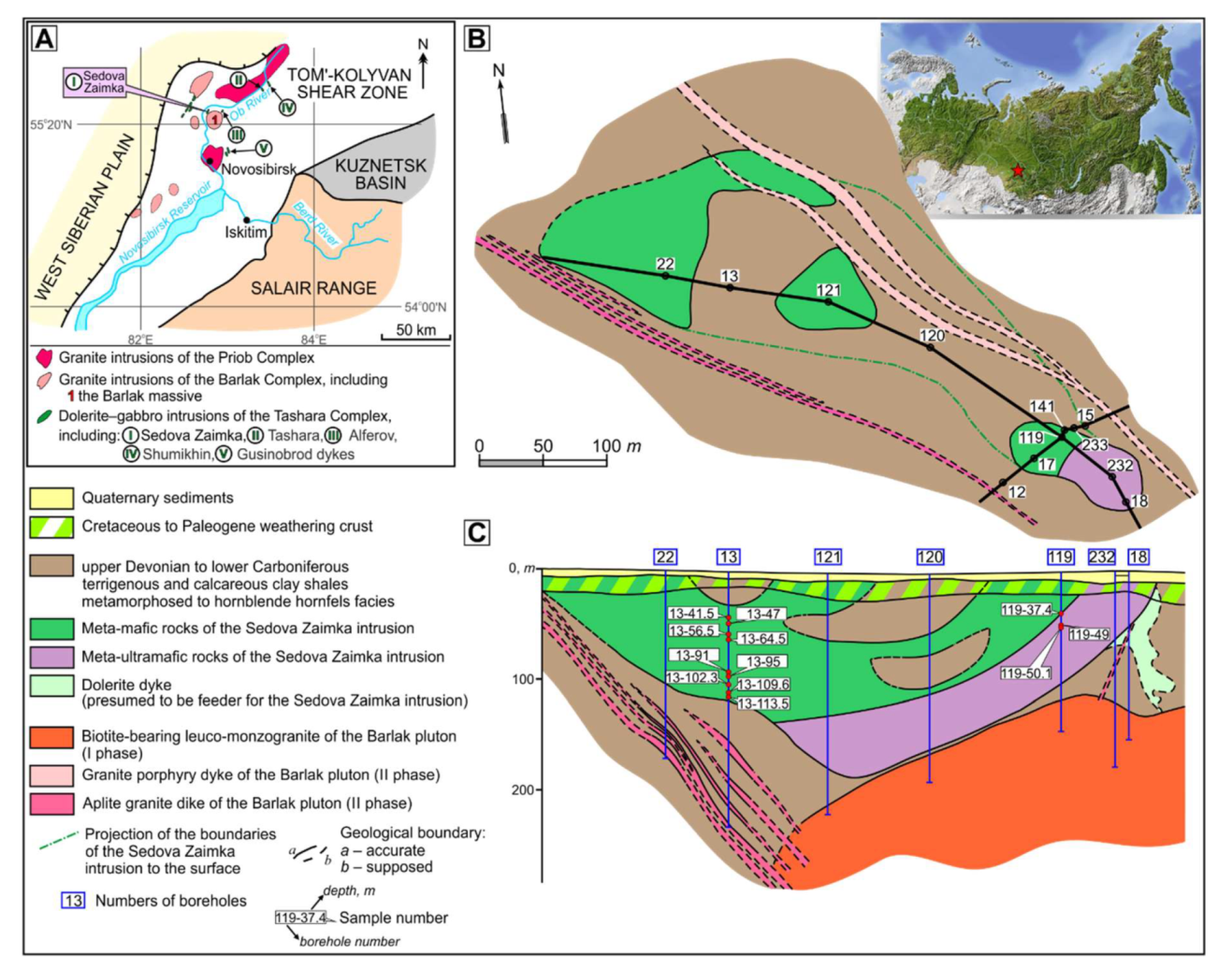
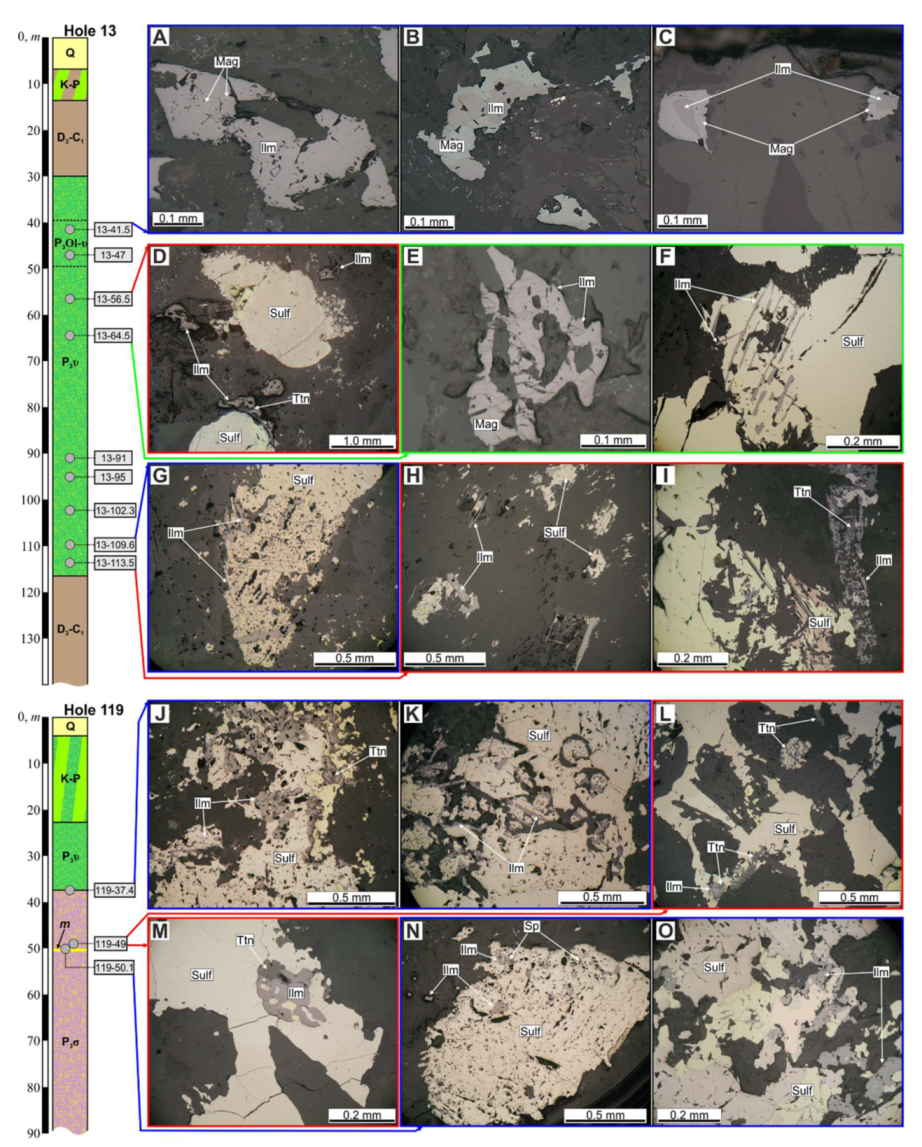
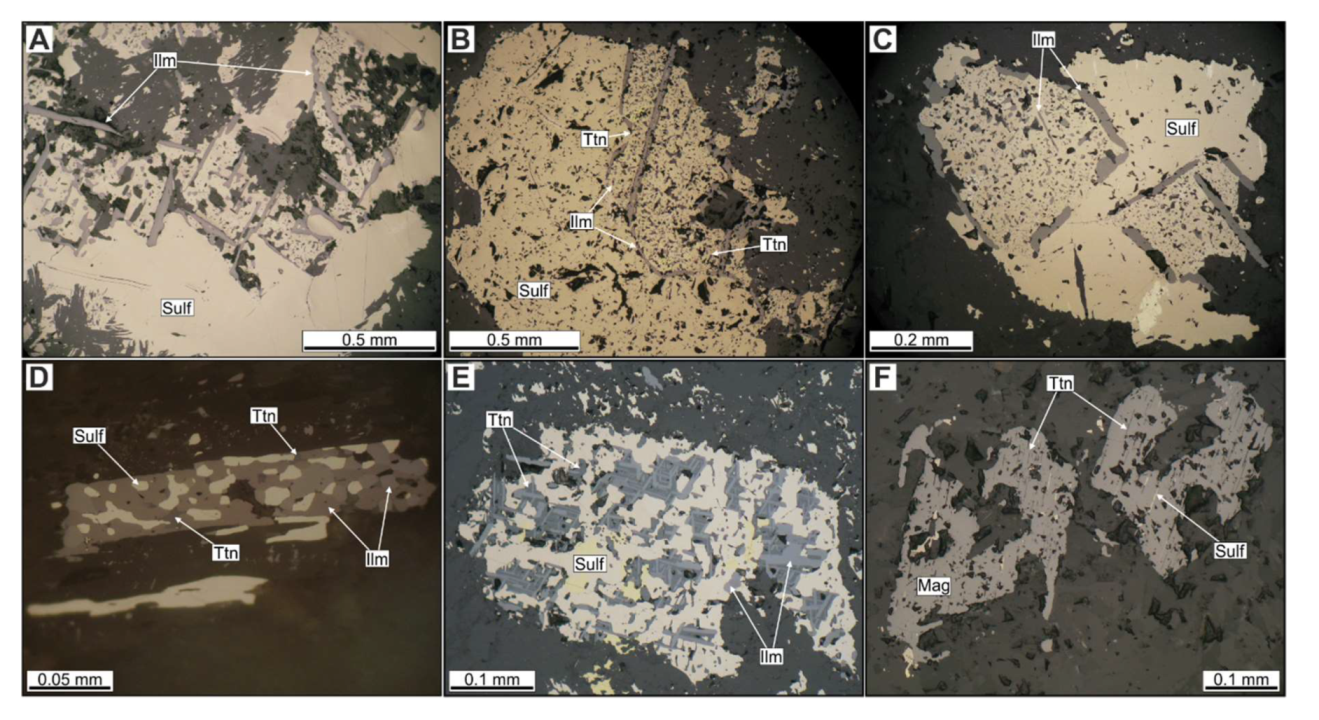

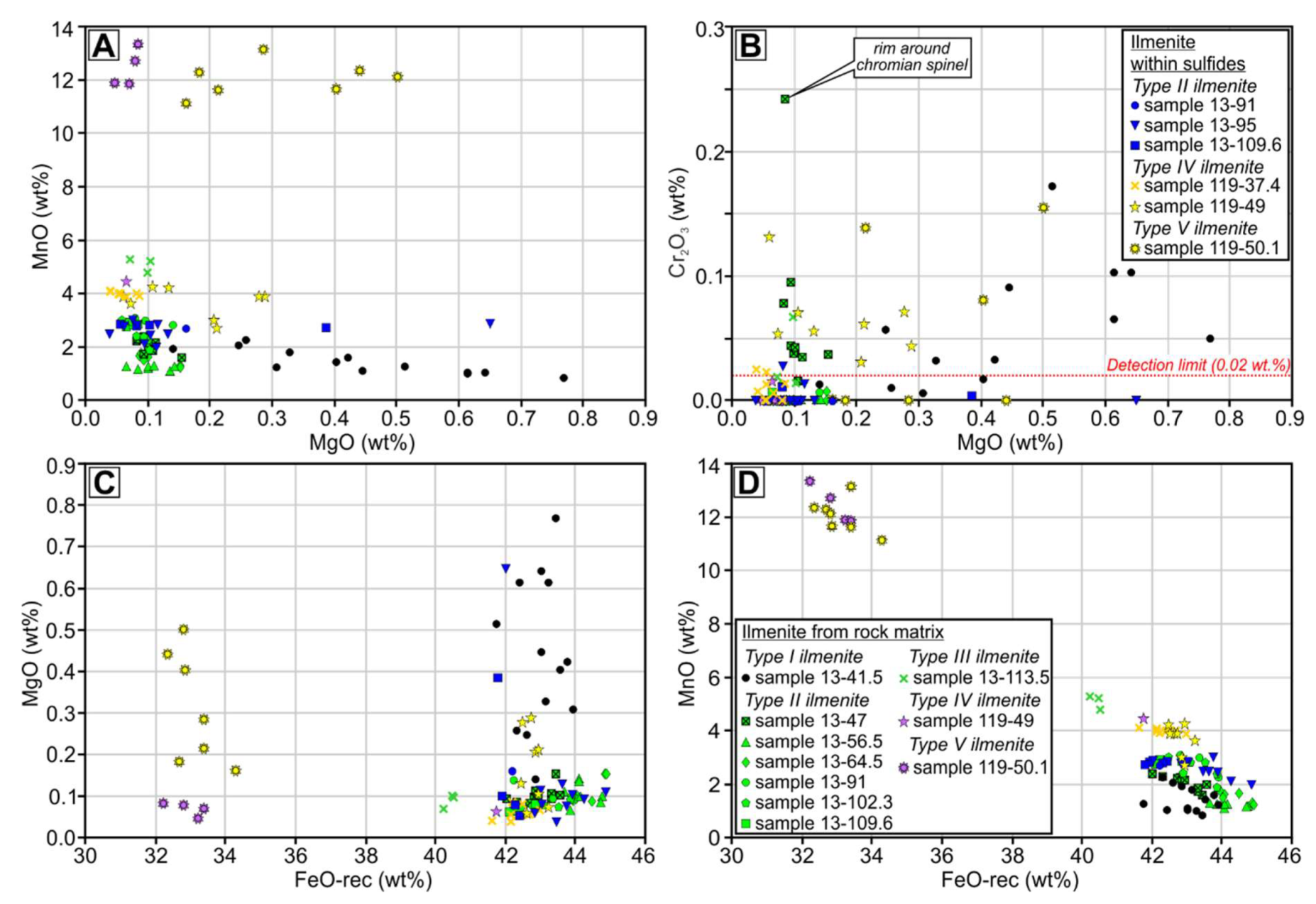
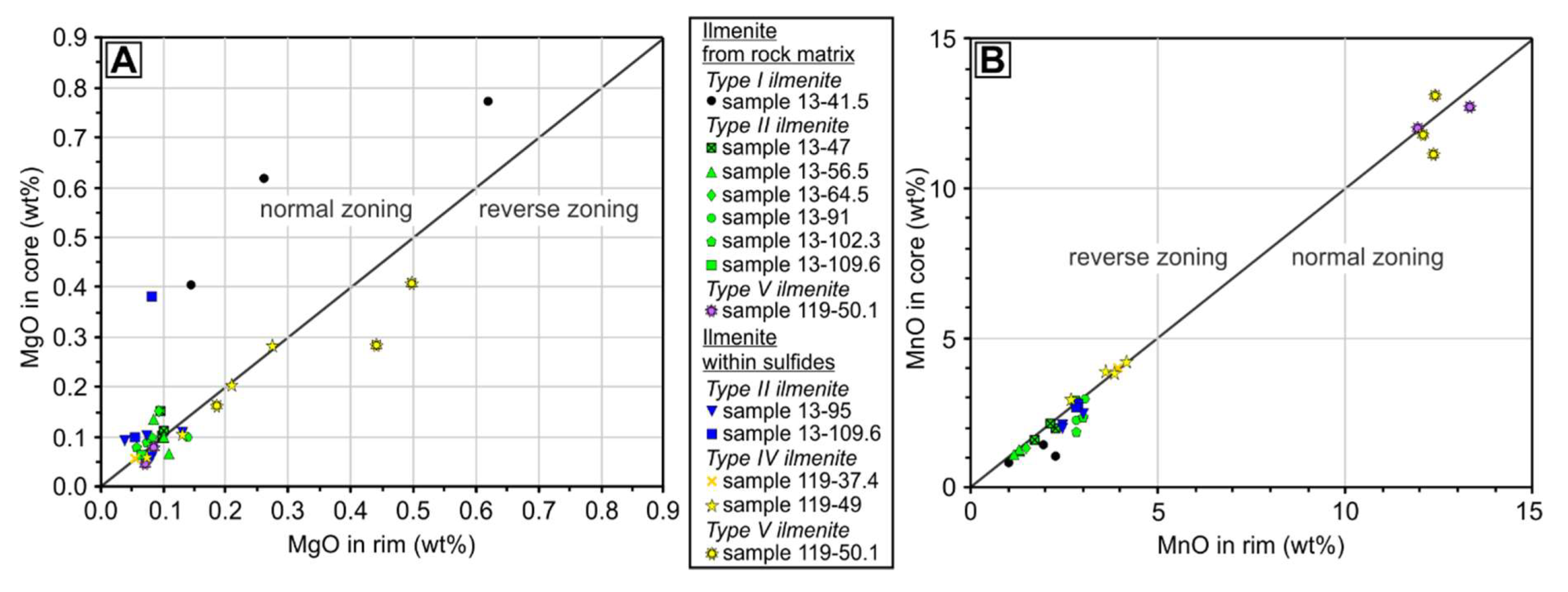
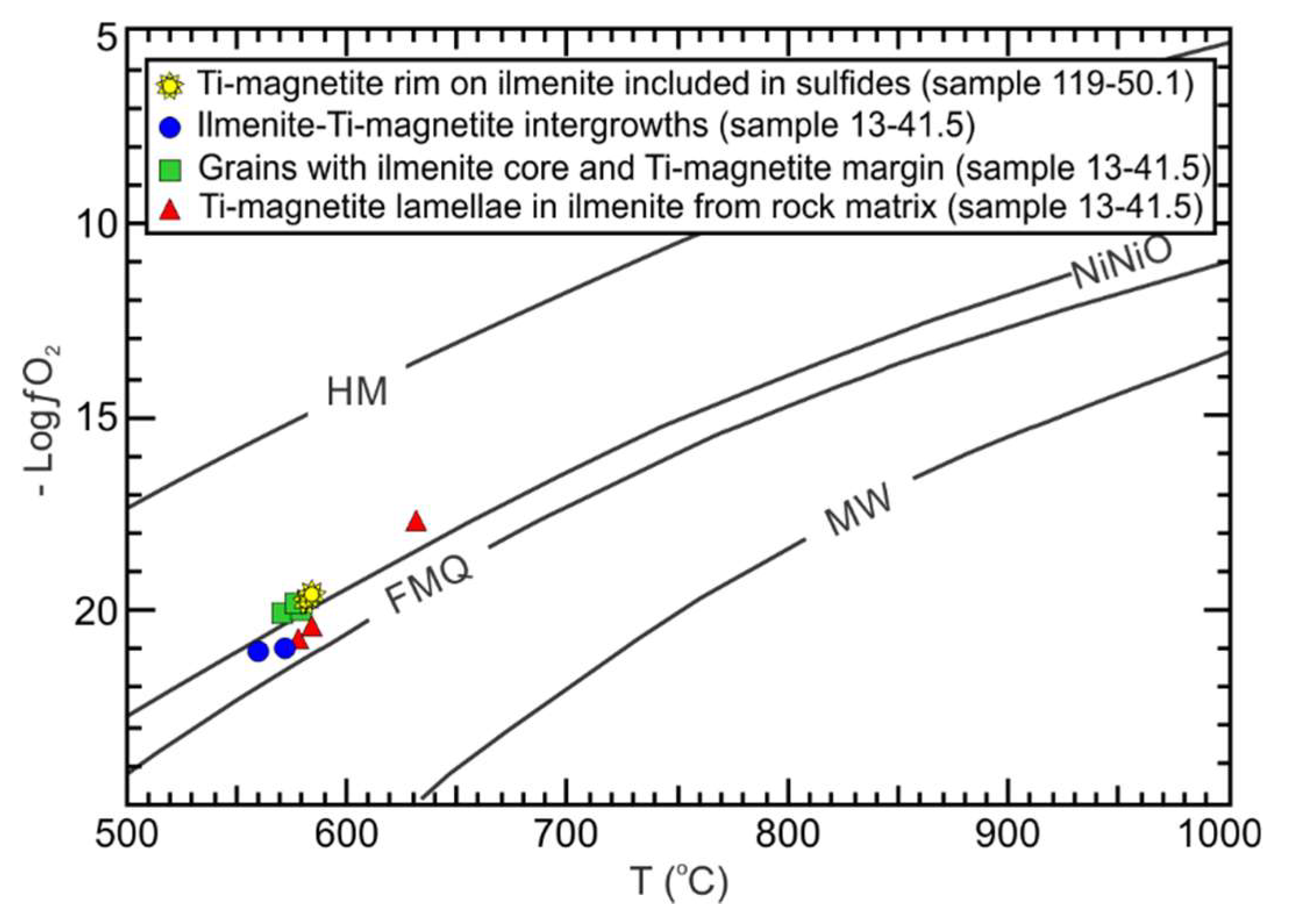
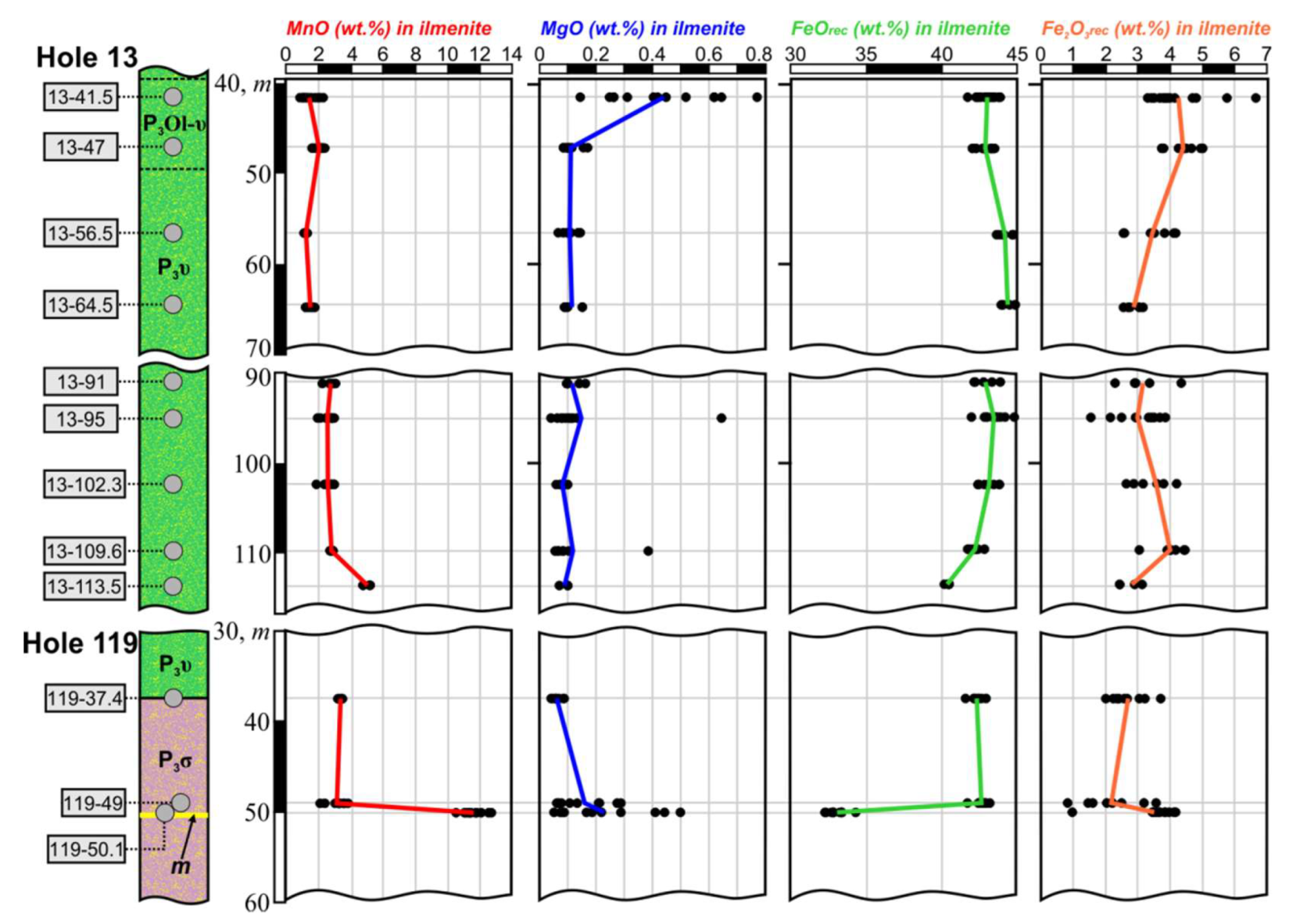
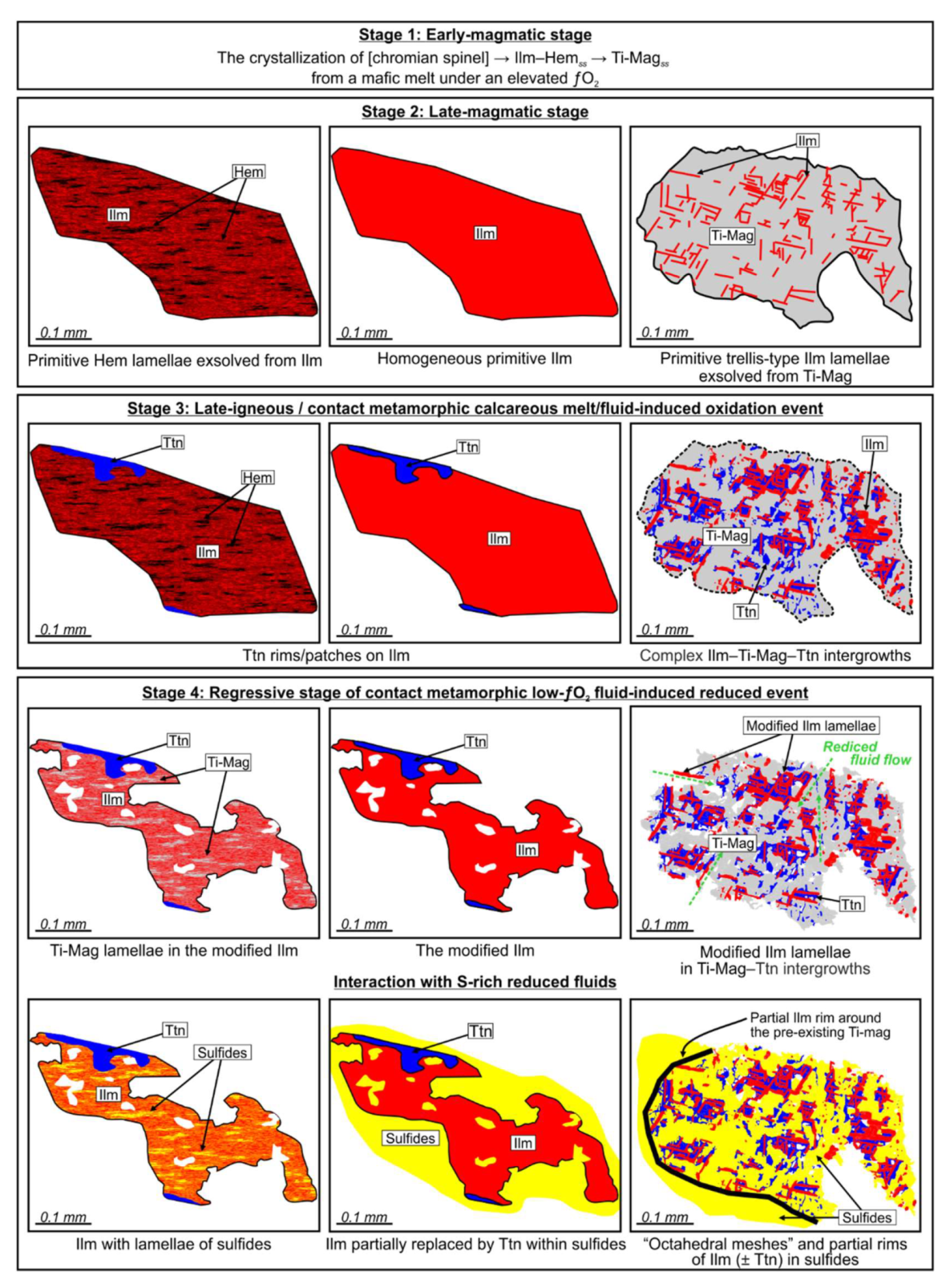
| Ilmenite Type | Distribution | Morphological Features | Composition Range (wt%) | Grain Zoning | ||||
|---|---|---|---|---|---|---|---|---|
| Grain Shape | Exsolutions, Intergrowths | Main Oxides | MnO | Other Impurities | ||||
| I | Meta-mafic unit | Olivine metagabbro (sample 13-41.5) | In rock matrix: euhedral to subhedral | (-) lamellae of Ti-magnetite; (-) intergrowths with Ti-magnetite; (-) Ti-magnetite mantles | TiO2 (48.9–51.3) FeOtotal (45.3–47.7) Fe2O3-rec * (3.3–6.7) | 1.0–2.5 | MgO (0.1–0.8); V2O5 (0.2–0.6); Cr2O3 (up to 0.2); negligible NiO and ZnO | Normal with respect to both MgO and MnO |
| Some stratigraphic levels (sample 13-64.5) | (-) as laths in Ti-magnetite and titanite; (-) lamellae of Ti-magnetite | |||||||
| II | Throughout the intrusion (samples 13-47, 13-56.5, 13-64.5, 13-91, 13-95, 13-102.3, and 13-109.6) | In rock matrix: euhedral to subhedral | Rare ilmenite rims around chromian spinel | TiO2 (50.1–52.0) FeOtotal (45.1–47.6) Fe2O3-rec (1.5–5.0) | 1.1–3.1 | MgO (up to 0.2); V2O5 (up to 0.6); Cr2O3 (up to 0.1); NiO (up to 0.3); ZnO (up to 0.5) | No to normal with respect to MnO; irregular distribution of MgO in marginal parts; | |
| Within sulfides: subhedral to anhedral, cord-like; “octahedral meshes” ** | Not observed | |||||||
| III | In the lower part of the intrusion (sample 13-113.5) | In rock matrix: euhedral to subhedral | Not observed | TiO2 (51.3–51.6) FeOtotal (42.7–43.1) Fe2O3-rec (2.4–3.1) | 4.5–5.3 | MgO (up to 0.1); V2O5 (0.1–0.3); Cr2O3 (up to 0.1); NiO (0.38–0.44); ZnO (0.45–0.51) | Insufficient to characterize | |
| Within sulfides: subhedral to anhedral, cord-like | Not observed | |||||||
| IV | Meta-ultramafic unit | Throughout the intrusion (samples 119-37.4 and 119-49) | In rock matrix: euhedral to subhedral; polycrystalline aggregates | Not observed | TiO2 (51.0–52.8) FeOtotal (43.7–46.2) Fe2O3-rec (0.8–3.7) | 2.7–4.5 | MgO (up to 0.3); V2O5 (up to 0.5); Cr2O3 (up to 0.1); negligible NiO and ZnO | No to weak reverse with respect to MgO; unzoned with respect to MnO |
| Within sulfides: subhedral to anhedral, cord-like; “octahedral meshes”; polycrystalline aggregates | Not observed | |||||||
| V | Massive sulfide mineralization (sample 119-50) | In rock matrix: euhedral to subhedral | Not observed | TiO2 (50.2–52.5) FeOtotal (34.3–37.4) Fe2O3-rec (1.0–4.5) | 11.1–13.3 | MgO (up to 0.5); V2O5 (0.1–0.3); negligible NiO, ZnO, and Cr2O3 | Reverse with respect to MgO; normal to reverse with respect to MnO | |
| Within sulfides: subhedral to anhedral, cord-like; “octahedral meshes” | Intergrowths with Cr-bearing hercynite | |||||||
© 2020 by the authors. Licensee MDPI, Basel, Switzerland. This article is an open access article distributed under the terms and conditions of the Creative Commons Attribution (CC BY) license (http://creativecommons.org/licenses/by/4.0/).
Share and Cite
Svetlitskaya, T.V.; Nevolko, P.A.; Fominykh, P.A. Fe-Ti Oxide Assemblages from the Contact-Metamorphosed Mafic-Ultramafic Rocks of the Sedova Zaimka Intrusion (Western Siberia, Russia): The Tracking of Metamorphic Transformations. Minerals 2020, 10, 253. https://doi.org/10.3390/min10030253
Svetlitskaya TV, Nevolko PA, Fominykh PA. Fe-Ti Oxide Assemblages from the Contact-Metamorphosed Mafic-Ultramafic Rocks of the Sedova Zaimka Intrusion (Western Siberia, Russia): The Tracking of Metamorphic Transformations. Minerals. 2020; 10(3):253. https://doi.org/10.3390/min10030253
Chicago/Turabian StyleSvetlitskaya, Tatyana V., Peter A. Nevolko, and Pavel A. Fominykh. 2020. "Fe-Ti Oxide Assemblages from the Contact-Metamorphosed Mafic-Ultramafic Rocks of the Sedova Zaimka Intrusion (Western Siberia, Russia): The Tracking of Metamorphic Transformations" Minerals 10, no. 3: 253. https://doi.org/10.3390/min10030253
APA StyleSvetlitskaya, T. V., Nevolko, P. A., & Fominykh, P. A. (2020). Fe-Ti Oxide Assemblages from the Contact-Metamorphosed Mafic-Ultramafic Rocks of the Sedova Zaimka Intrusion (Western Siberia, Russia): The Tracking of Metamorphic Transformations. Minerals, 10(3), 253. https://doi.org/10.3390/min10030253





